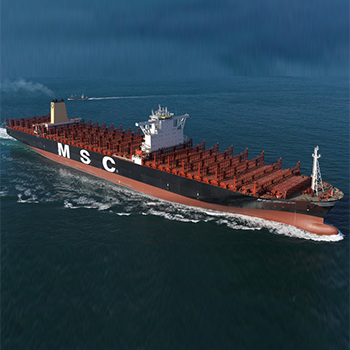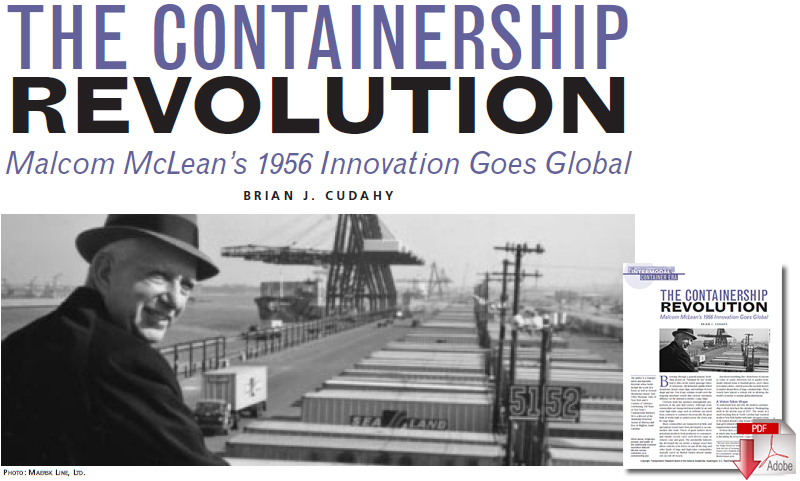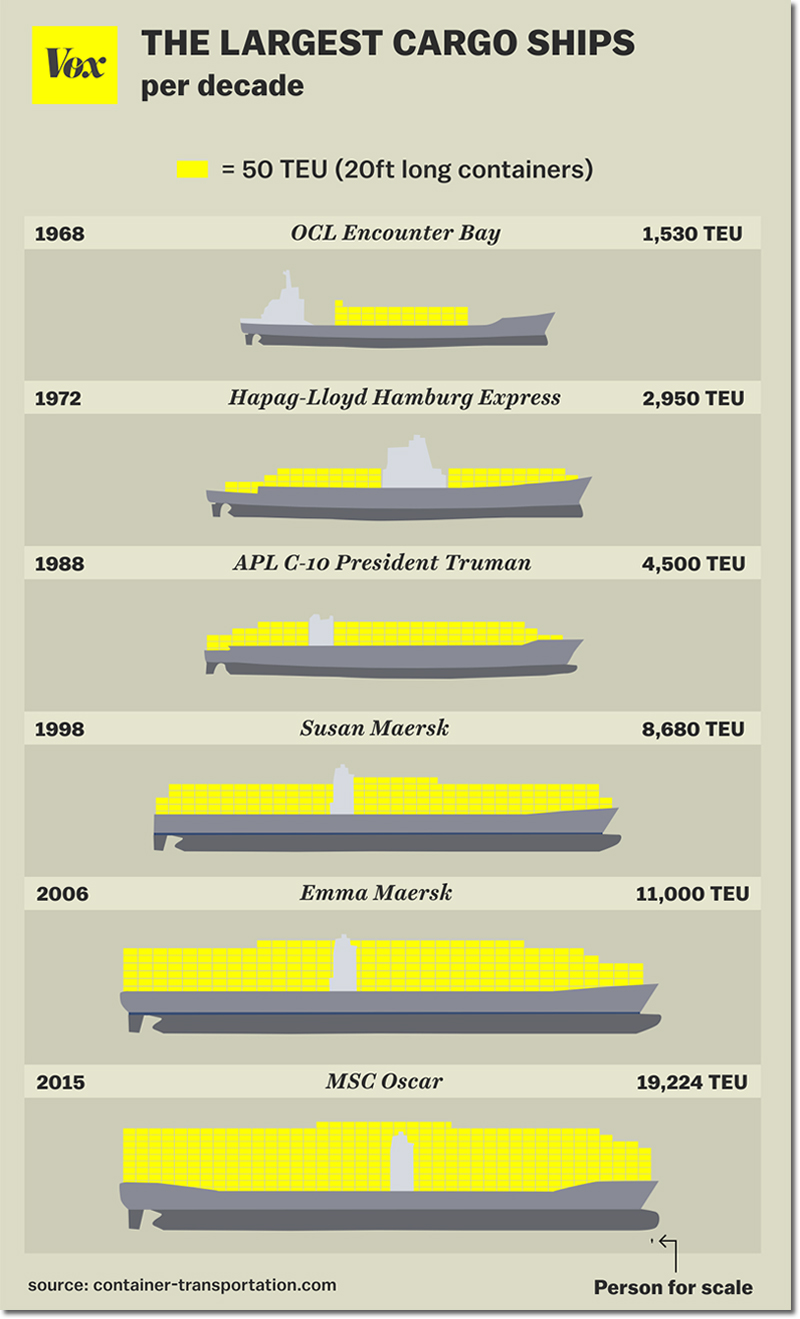The World’s Biggest Container Ship (for now!)

The MSC Oscar sailed from its shipyard in South Korea in January, and managed to steal the title of “World’s Biggest Ship” right from under the CSCL Globe’s nose.
The MSC Oscar set sail from a shipyard near Busan, South Korea, and became the world’s largest container ship.
This ship is so big that it’s hard to comprehend without seeing in person.
The deck of the Oscar is nearly as big as four football fields laid end-to-end and can carry more than 19,000 shipping containers.
In more tangible terms: this single ship can carry 39,000 cars or 117 million pairs of sneakers. And it’s just the latest stage in the explosive growth of container ships since they debuted in the 1950s.
How Container Ships Got So Huge
Until 1956, most international cargo was manually packed in the holds of shipping boats by dock workers, and manually unloaded when it reached port.
But in 1937, North Carolina trucking company owner Malcom McLean grew frustrated by how long this process took as he waited for workers to pack up cotton he’d trucked up to New York harbor, to be sent to Istanbul.
McLean had the idea to use cranes to directly load truck trailers onto the ship. It took a while, but in 1956, he debuted the Ideal X - the very first container ship, a converted tanker that could carry 58 containers.
The next year, he launched the much-larger Gateway City, which could hold 226 containers, stacked in racks.
During the 1960s, he launched even bigger container ships, and his company Pan American began to dominate the shipping industry - his system dramatically cut down on time in port, as well as the labor needed to load and unload cargo. The containers also helped secure goods, cutting down on theft.
Other companies copied his methods, and shipping containers now come in standardized sizes (they are now 8 feet wide, 20 or 40 feet long, and 8, 8.5 or 9.5 feet tall). By the end of the 1970s, the majority of consumer goods coming to the US were being shipped by container.
Eventually, the trend led to an arms race between shippers, because larger boats meant lower shipping prices per container: roughly the same amount of sailors were needed on a ship regardless of size, and proportionately less fuel per container was needed to move larger ones.
This led to the huge growth in ship size we’ve seen. To accommodate these giant ships, ports were rebuilt, with vast yards to store the containers, huge cranes to load and unload them, and highway and rail terminals to send them directly on their way.
The Panama canal is currently being widened to accommodate larger ships, but even after the project is finished in 2016, it won’t be able to fit the Oscar. And today’s biggest ships are so huge that they can’t actually dock at any American ports - they’re used mostly for shipping between Europe and Asia. However, the Nicaragua Canal - if it’s ever completed - would be big enough to accommodate these ships, and there are proposals to dredge the Port of Norfolk, among others, to allow them to dock in the United States.
Related: ILWU Panama Division Panama Canal Pilots Voice Safety Concerns Over New Canal Navigation

It’s hard to overstate how much all of this has changed the world economy. Before the container ship, transoceanic shipping was so expensive that it didn’t make sense to send most goods around the world.
Now, it’s cheap - which, combined with-free trade policies, means that vendors in wealthy countries like the United States can efficiently take advantage of cheap labor abroad. For the American consumer, it means that the vast majority of goods - shoes, clothes, flat-screen TVs, basketballs, even toothbrushes - come from abroad, via container.
The US now imports more than 17 million containers of cargo per year, with about 60 percent coming from Asia. The biggest ports - Los Angeles, Long Beach, Newark, and Savannah - each handle more than 2 million containers per year. Recently, companies have even begun shipping bulk food products on container ships.
And the truly amazing thing is that the Oscar probably won’t hold the record for long. A different ship - the CSCL Globe - previously set the record in November (and is actually a bit longer and wider than Oscar, but can’t carry quite as many container). Meanwhile, a sister ship of identical size is being launched by the same company (Mediterranean Shipping Company) in April.
Shipping experts are speculating that ships capable of holding more than 20,000 containers may be built soon.
Source: Vox
Related: World’s Second Largest Container Ship Arrives in the UK for the First Time

Article Topics
One Network Enterprises News & Resources
Blue Yonder announces an agreement to acquire One Network Enterprises for $839 million Blue Yonder Acquires One Network Enterprises for $839M Companies Need to Develop New Innovative Approaches to Supply Chain Design How to Improve Cost of Goods Sold Horizontally Across the Supply Chain How the Global Pandemic Accelerated Supply Chain Visibility, Digitalization, and Automation AI and Data, the Future of Supply Chain Management AI and Supply Chain Problem Solving More One Network EnterprisesLatest in Transportation
FedEx Announces Plans to Shut Down Four Facilities The Two Most Important Factors in Last-Mile Delivery Most Companies Unprepared For Supply Chain Emergency Baltimore Bridge Collapse: Impact on Freight Navigating Amazon Logistics’ Growth Shakes Up Shipping Industry in 2023 Nissan Channels Tesla With Its Latest Manufacturing Process Why are Diesel Prices Climbing Back Over $4 a Gallon? More Transportation















